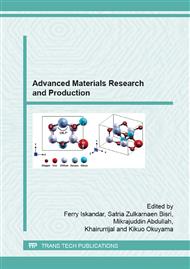p.528
p.533
p.538
p.542
p.546
p.550
p.555
p.559
p.563
Physical and Chemical Characteristics of Corals from Bidong Island, Terengganu, Malaysia
Abstract:
Coral and converted coralline hydroxyapatites have been widely used in biomedical application as orbital implant and bone graft substitute. The aim of this study was to characterize the physical and chemical properties of various corals found in Bidong Island and determines their potential for development of bone graft substitute. Five species of coral which is commonly found in Bidong Island, Terengganu was collected and identified. The physical properties of corals such as density and porosity were determined using the Archimedes Principle, whereas a mechanical strength was determined using a universal testing machine. The structure of corals such as pore sizes and shape, distribution and pore connectivity was observed using Scanning Electron Microscope (SEM). Chemical properties of corals were characterized using X-ray diffraction (XRD), and energy dispersive x-ray (SEM-EDX). Five species of coral were identified as Leptoria, Porites, Platygyra, Acropora and Pocillopora. The densities of corals range from 2.00 to 19.00 g/cm3 while the porosity range from 15 to 60%. The corals structure consists of interconnected open pores with mean pore sizes in range of 100 to 600μm. Their compressive strengths are in the range of 4.92 to 27 MPa, which is higher than the reported strength for cancellous bone. SEM-EDX analysis shows the elements calcium carbonate (C, O and Ca) found in Platygyra. This result was supported by XRD analysis, which shows the calcium carbonate phase in form of aragonite presence in Platygyra. Aragonite phase was suitable for transforming coral to hydroxyapatite via hydrothermal treatment. Based on this finding, coral species in Bidong Island, Terengganu has been great potential to be used as bone graft substitutes.
Info:
Periodical:
Pages:
555-558
Citation:
Online since:
July 2015
Price:
Сopyright:
© 2015 Trans Tech Publications Ltd. All Rights Reserved
Share:
Citation:


